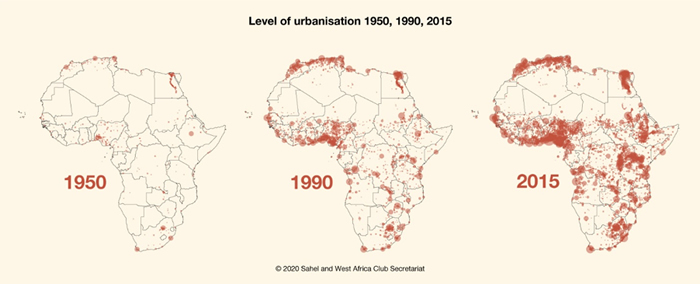Understanding Africa’s urban geography is a top priority: New SWAC/OECD report

Fuelled by rapid population growth Africa is experiencing the fastest urban growth anywhere in the world: the continent’s population is projected to double between now and 2050 and in the next 30 years, its cities will be home to an additional 950 million people. Policy makers should fully appreciate the profound urban transformations occurring in Africa in order to seize the new opportunities offered by an already urban continent, recommends a new SWAC/OECD report launched today at an event jointly organised with the African Union Development Agency (AUDA-NEPAD) on the margins of the 33rd African Union Summit in Addis Ababa, Ethiopia.
H.E. Dr Ibrahim Mayaki, AUDA-NEPAD’s CEO and Sahel and West Africa Club (SWAC) Honorary President, urged participants at the launch to think about the continent's urban geography differently, stating that policies need to catch up and be more multi-dimensional and inclusive.
His sentiments were echoed by Angolan Minister for Social Affairs, H.E Carolina Cerqueira, who remarked that, “In planning for urbanisation in Africa, we need to ensure that our public policies are inclusive of everyone.”
A key challenge is the lack of available data and evidence to better inform policy-making. The spatial approach adopted in this report identifies and tracks the transformations taking place on the ground and describes the underlying forces behind local, regional and continental urbanisation. Based on the Africapolis geo-spatial database (www.africapolis.org) mapping 7 600 urban agglomerations in 50 African countries, the report provides detailed analyses of major African urbanisation dynamics placed within historical, environmental and political contexts. Covering the entire spectrum of the urban network — from small towns and intermediary cities to large metropolitan regions — it develops more inclusive and targeted policy options that integrate social and environmental dimensions, and acknowledge the role of urban agglomerations as economic and social drivers.
It is against this setting that H.E Josefa Sacko, African Union Commissioner for Rural Economy and Agriculture declared that, “We need to change the narrative on African cities. The report Africa's Urbanisation Dynamics constitutes an important tool for urban planning on the continent.” A point that was taken up again by H.E Sarah Anyang Agbor, African Union Commissioner for Human Resources, Science and Technology, who asserted that identification and contextualisation of urban realities is key to achieving “The Africa We Want” vision of Agenda 2063.
The report highlights the existence of thousands of urban agglomerations that are not recorded in official statistics, in areas generally considered rural. The extent of this phenomenon is striking, and does not only concern small towns, or the suburbs of big cities, but agglomerations of all sizes. Some have more than one million inhabitants: Onitsha (Nigeria); Sodo and Hawassa (Ethiopia); Kisii and Kisumu (Kenya); Bafoussam (Cameroon); and Mbale (Uganda). Their emergence is driven by rural demographic transformations, which lead to widespread in situ urbanisation and, as a result, blur the lines between rural and urban.
During the report launch, Mr Philipp Heinrigs, Head of Unit at SWAC/OECD, stressed that Africa is already urban. “Africa's urban planning and realities therefore need to be included across the whole range of sectors,” he said.

According to the report, the continued emergence of small and intermediary cities — 210 million Africans live in one of the continent’s 1 400 intermediary cities — is driving a fundamental shift in Africa’s urban landscape. This trend is challenging the primacy of the African megacities that have until now attracted a large share of human and financial capital, leading to uneven economic growth at the expense of secondary cities and rural areas.
Africa’s small and medium-sized urban agglomerations are developing most often without the necessary policy support or investments to render this growth sustainable and translate it into better social and economic outcomes for its citizens. Yet,medium-sized cities and small towns are vital in structuring the African urban network and connecting the local and regional to the continental and global levels. There is an urgent need for socio-economic and financial policies to reflect their growing importance in programming and planning decisions, suggests the report.
The diverse and multifaceted nature of Africa’s contemporary urban transition gives rise to novel forms and scales of urban development. In several countries, new settlement and mobility patterns lead to the emergence of large metropolitan regions around metropoles with high urban concentration. As assessed by the report, this structure of urban dynamics, sometimes across borders (e.g. the Greater Ibadan-Lagos-Accra corridor), displays strong potential for regional integration, while at the same time creating a disconnection from the rest of the national territory.
High level panellists at the report launch included: Prof Sarah Anyang Agbor, African Union Commissioner for Human Resources, Science and Technology; H.E Jean-Pierre Elong Mbassi, Secretary-General, United Cities and Local Governments of Africa; Mr Ahmed Aziz Diallo, MP-Mayor of Dori, Burkina Faso; Ms Wanjira Mathai, Vice President and Regional Director for Africa, World Resources Institute; Ms Thokozile Ruzvidzo, Director of Gender, Poverty and Social Policy Division, GPSPD, United Nations Economic Commission for Africa; and Ms Yvonne Aki-Sawyerr OBE, Mayor of Freetown, Sierra Leone, who sent a video message.
In conclusion, Dr Francois Yatta Director of the UCLG Africa programmes and SWAC/OECD announced the next meeting to continue discussions will take place in Paris at the end of June.
Africa’s Urbanisation Dynamics 2020: Africapolis, Mapping a New Urban Geography raises questions on expanding spontaneous urbanisation, densification of territories, strong demographic growth and protection of the environment, and suggests the urgent necessity of developing adapted new policies to reconcile urban and sustainability concerns. Nevertheless, the design of appropriate and efficient policy interventions depends on better understanding and recognition of these realities.
Visualise more data on African cities
Shaping Africa’s Urban Future Together
For further information, journalists should contact:
SWAC/OECD Lia Beyeler | Lia.BEYELER@oecd.org / AUDA-NEPAD Mwanja Ng'anjo | MwanjaN@nepad.org
